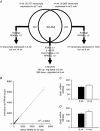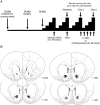Loss of Cdk5 function in the nucleus accumbens decreases wheel running and may mediate age-related declines in voluntary physical activity
- PMID: 27461471
- PMCID: PMC5199738
- DOI: 10.1113/JP272489
Loss of Cdk5 function in the nucleus accumbens decreases wheel running and may mediate age-related declines in voluntary physical activity
Abstract
Key points: Physical inactivity, which drastically increases with advancing age, is associated with numerous chronic diseases. The nucleus accumbens (the pleasure and reward 'hub' in the brain) influences wheel running behaviour in rodents. RNA-sequencing and subsequent bioinformatics analysis led us to hypothesize a potential relationship between the regulation of dendritic spine density, the molecules involved in synaptic transmission, and age-related reductions in wheel running. Upon completion of follow-up studies, we developed the working model that synaptic plasticity in the nucleus accumbens is central to age-related changes in voluntary running. Testing this hypothesis, inhibition of Cdk5 (comprising a molecule central to the processes described above) in the nucleus accumbens reduced wheel running. The results of the present study show that reductions in synaptic transmission and Cdk5 function are related to decreases in voluntary running behaviour and provide guidance for understanding the neural mechanisms that underlie age-dependent reductions in the motivation to be physically active.
Abstract: Increases in age are often associated with reduced levels of physical activity, which, in turn, associates with the development of numerous chronic diseases. We aimed to assess molecular differences in the nucleus accumbens (NAc) (a specific brain nucleus postulated to influence rewarding behaviour) with respect to wheel running and sedentary female Wistar rats at 8 and 14 weeks of age. RNA-sequencing was used to interrogate transcriptomic changes between 8- and 14-week-old wheel running rats, and select transcripts were later analysed by quantitative RT-PCR in age-matched sedentary rats. Voluntary wheel running was greatest at 8 weeks and had significantly decreased by 12 weeks. From 619 differentially expressed mRNAs, bioinformatics suggested that cAMP-mediated signalling, dopamine- and cAMP-regulated neuronal phosphoprotein of 32 kDa feedback, and synaptic plasticity were greater in 8- vs. 14-week-old rats. In depth analysis of these networks showed significant (∼20-30%; P < 0.05) decreases in cell adhesion molecule (Cadm)4 and p39 mRNAs, as well as their proteins from 8 to 14 weeks of age in running and sedentary rats. Furthermore, Cadm4, cyclin-dependent kinase 5 (Cdk5) and p39 mRNAs were significantly correlated with voluntary running distance. Analysis of dendritic spine density in the NAc showed that wheel access increased spine density (P < 0.001), whereas spine density was lower in 14- vs. 8-week-old sedentary rats (P = 0.03). Intriguingly, intra-NAc injection of the Cdk5 inhibitor roscovitine, dose-dependently decreased wheel running. Collectively, these experiments suggest that an age-dependent loss in synaptic function and Cdk5/p39 activity in the NAc may be partially responsible for age-related declines in voluntary running behaviour.
Keywords: Cdk5; nucleus accumbens; physical activity; reward; synapse; wheel running.
© 2016 The Authors. The Journal of Physiology © 2016 The Physiological Society.
Figures








Similar articles
-
Effects of intrinsic aerobic capacity and ovariectomy on voluntary wheel running and nucleus accumbens dopamine receptor gene expression.Physiol Behav. 2016 Oct 1;164(Pt A):383-9. doi: 10.1016/j.physbeh.2016.06.006. Epub 2016 Jun 11. Physiol Behav. 2016. PMID: 27297873 Free PMC article.
-
Mu opioid receptor modulation in the nucleus accumbens lowers voluntary wheel running in rats bred for high running motivation.Neuropharmacology. 2015 Oct;97:171-81. doi: 10.1016/j.neuropharm.2015.05.022. Epub 2015 Jun 1. Neuropharmacology. 2015. PMID: 26044640
-
Mu-opioid receptor inhibition decreases voluntary wheel running in a dopamine-dependent manner in rats bred for high voluntary running.Neuroscience. 2016 Dec 17;339:525-537. doi: 10.1016/j.neuroscience.2016.10.020. Epub 2016 Oct 13. Neuroscience. 2016. PMID: 27743985
-
Recent advances in understanding the roles of Cdk5 in synaptic plasticity.Biochim Biophys Acta. 2009 Aug;1792(8):741-5. doi: 10.1016/j.bbadis.2009.05.001. Epub 2009 May 13. Biochim Biophys Acta. 2009. PMID: 19442718 Review.
-
[Roles of cyclin-dependent kinase 5 in central nervous system development and neurodegenerative diseases].Sheng Li Xue Bao. 2010 Aug 25;62(4):295-308. Sheng Li Xue Bao. 2010. PMID: 20717630 Review. Chinese.
Cited by
-
Voluntary wheel running promotes resilience to chronic social defeat stress in mice: a role for nucleus accumbens ΔFosB.Neuropsychopharmacology. 2018 Aug;43(9):1934-1942. doi: 10.1038/s41386-018-0103-z. Epub 2018 May 24. Neuropsychopharmacology. 2018. PMID: 29875450 Free PMC article.
-
Comparative mRNA profile analysis from NAc of adolescent male mice after binge-like alcohol exposure eliciting deficits in context fear extinction learning.PLoS One. 2025 Jun 25;20(6):e0322576. doi: 10.1371/journal.pone.0322576. eCollection 2025. PLoS One. 2025. PMID: 40560842 Free PMC article.
-
Creatine Supplementation Upregulates mTORC1 Signaling and Markers of Synaptic Plasticity in the Dentate Gyrus While Ameliorating LPS-Induced Cognitive Impairment in Female Rats.Nutrients. 2021 Aug 11;13(8):2758. doi: 10.3390/nu13082758. Nutrients. 2021. PMID: 34444918 Free PMC article.
-
Yearning predicts subgenual anterior cingulate activity in bereaved individuals.Heliyon. 2018 Oct 13;4(10):e00852. doi: 10.1016/j.heliyon.2018.e00852. eCollection 2018 Oct. Heliyon. 2018. PMID: 30364703 Free PMC article.
-
Role of cyclin-dependent kinase 5 in early brain injury following experimental subarachnoid hemorrhage.Exp Ther Med. 2022 Feb;23(2):147. doi: 10.3892/etm.2021.11070. Epub 2021 Dec 15. Exp Ther Med. 2022. PMID: 35069828 Free PMC article.
References
-
- Anantharaman‐Barr HG & Decombaz J (1989). The effect of wheel running and the estrous cycle on energy expenditure in female rats. Physiol Behav 46, 259–263. - PubMed
-
- Andersen SL (2002). Changes in the second messenger cyclic AMP during development may underlie motoric symptoms in attention deficit/hyperactivity disorder (ADHD). Behav Brain Res 130, 197–201. - PubMed
-
- Anderson CH (1982). Changes in dendritic spine density in the preoptic area of the female rat at puberty. Brain Res Bull 8, 261–265. - PubMed
-
- Arnold JM & Roberts DC (1997). A critique of fixed and progressive ratio schedules used to examine the neural substrates of drug reinforcement. Pharmacol Biochem Behav 57, 441–447. - PubMed
MeSH terms
Substances
LinkOut - more resources
Full Text Sources
Other Literature Sources
Medical

